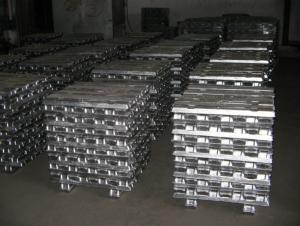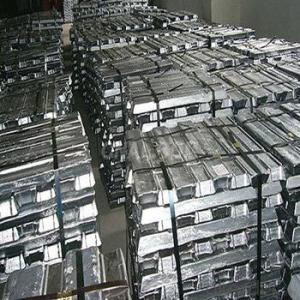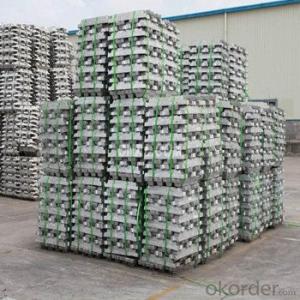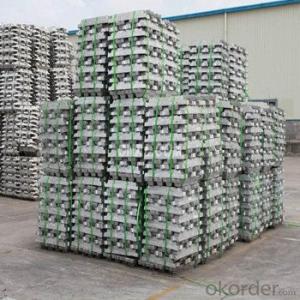Aluminum Pig/Ingot Made In China Directly
- Loading Port:
- China main port
- Payment Terms:
- TT OR LC
- Min Order Qty:
- 1000 m.t.
- Supply Capability:
- 100000 m.t./month
OKorder Service Pledge
OKorder Financial Service
You Might Also Like
Pure Aluminum Pig/Ingot Used for Industry
1.Structure of Aluminum Pig/Ingot
A material that has been cast into a shape in order to be transported and processed easier than in an unprocessed form. An ingot is typically rectangular in shape, which allows it to be stacked. Ingots are most commonly associated with metals, with ingots of gold held in the vaults of banks and brokerages being popular images.
Aluminum Ingot is with the AL as the main chemical composition.Aluminum Ingot is used for industry,such as automobile,pinning and weaving,electron broadly and so on. Aluminum Ingot has the following advantages: easy control and operation, fast melting.
2.Main Features of the Aluminum Pig/Ingot
•High Purity
•Easy control and operation
•High strength
•Fast melting
•Competitive price
•Best Service
3.Aluminum Pig/Ingot Images


4.Aluminum Pig/Ingot Specification
Grade | Chemical Composition % | |||||||||
Al≥ | impurities ≤ | |||||||||
Si | Fe | Cu | Ga | Mg | Zn | Mn | others | Sum | ||
Al99.9 | 99.90 | 0.50 | 0.07 | 0.005 | 0.02 | 0.01 | 0.025 | - | 0.010 | 0.10 |
Al99.85 | 99.85 | 0.80 | 0.12 | 0.005 | 0.03 | 0.02 | 0.030 | - | 0.015 | 0.15 |
Al99.7 | 99.70 | 0.10 | 0.20 | 0.010 | 0.03 | 0.02 | 0.030 | - | 0.030 | 0.30 |
Al99.6 | 99.60 | 0.16 | 0.25 | 0.010 | 0.03 | 0.03 | 0.030 | - | 0.030 | 0.40 |
Al99.5 | 99.50 | 0.22 | 0.30 | 0.020 | 0.03 | 0.05 | 0.050 | - | 0.030 | 0.50 |
Al99.00 | 99.00 | 0.42 | 0.50 | 0.020 | 0.03 | 0.05 | 0.050 | - | 0.050 | 1.00 |
5.FAQ of Aluminum Pig/Ingot
We have organized several common questions for our clients,may help you sincerely:
①How about your company?
A big and famous and professional manufacturer & supplier of Aluminum Pig/Ingot, is one of the one of the large-scale professional investment Aluminum Pig/Ingot production bases in China.It have focuses on producing the Aluminum Pig/Ingot production for many years and gotten rich experience.Annually lagrge amount of Aluminum Pig/Ingot production are exported to markets in Europe,America and Japan. The quality and service have also gotten OEM service is available according to customer’s requirements.
②How to guarantee the quality of the products?
We have established the international advanced quality management system,every link from raw material to final product we have strict quality test;We resolutely put an end to unqualified products flowing into the market. At the same time, we will provide necessary follow-up service assurance.
③How long can we receive the product after purchase?
In the purchase of product within three wo We have organized several common questions for our clients,may help you sincerely:
①How about your company?
A big and famous and professional manufacturer & supplier of Aluminum Pig/Ingot, is one of the one of the large-scale professional investment Aluminum Pig/Ingot production bases in China.It have focuses on producing the Aluminum Pig/Ingot production for many years and gotten rich experience.Annually lagrge amount of Aluminum Pig/Ingot production are exported to markets in Europe,America and Japan. The quality and service have also gotten OEM service is available according to customer’s requirements.
②How to guarantee the quality of the products?
We have established the international advanced quality management system,every link from raw material to final product we have strict quality test;We resolutely put an end to unqualified products flowing into the market. At the same time, we will provide necessary follow-up service assurance.
③How long can we receive the prod rking days, We will arrange the factory delivery as soon as possible. The pecific time of receiving is related to the state and position of customers.Commonly 7 to 10 working days can be served.
- Q: Can aluminum ingots be customized for specific applications?
- Yes, aluminum ingots can be customized for specific applications. Aluminum is a highly versatile metal that can be easily manipulated to meet various requirements. The customization process typically involves alloying the aluminum with other elements to enhance its properties such as strength, hardness, corrosion resistance, and thermal conductivity. Additionally, the ingots can be subjected to various heat treatment processes like annealing, quenching, and tempering to further modify their properties. This allows for the production of aluminum ingots that are tailored to specific applications, ranging from automotive parts and aerospace components to construction materials and consumer products.
- Q: How are aluminum ingots used in the production of lighting fixtures?
- Aluminum ingots play a crucial role in the production of lighting fixtures due to their unique properties and versatility. Firstly, aluminum is lightweight yet highly durable, making it an ideal material for manufacturing various components of lighting fixtures, such as the body, base, or frame. Its lightweight nature allows for easier installation and transportation, while its durability ensures the longevity of the fixture. Moreover, aluminum has excellent thermal conductivity, which is essential for lighting fixtures as it helps dissipate heat generated by the bulbs. This property allows the fixture to remain cool and prevents overheating, ensuring the safety and efficiency of the lighting system. In addition, aluminum ingots can be easily molded into different shapes and sizes, enabling the production of intricate and aesthetically pleasing lighting fixtures. This flexibility in design allows manufacturers to create a wide range of styles, from sleek and modern to classic and ornate, catering to various consumer preferences. Furthermore, aluminum is highly corrosion-resistant, which is particularly important for lighting fixtures that may be exposed to outdoor elements or high levels of moisture. This property ensures that the fixture remains intact and maintains its appearance, even under harsh conditions. Lastly, aluminum ingots are also environmentally friendly, as they can be easily recycled and have a low carbon footprint compared to other materials. This makes aluminum an attractive choice for lighting fixture manufacturers who prioritize sustainability and want to reduce their environmental impact. Overall, aluminum ingots are indispensable in the production of lighting fixtures due to their lightweight, durable, and thermally conductive properties, as well as their versatility in design and environmental friendliness.
- Q: How is aluminium ingot made?
- Aluminum is the world's output and consumption of ferrous metals only next to steel. The density of aluminum is only about 2.7103g/cm3[1], about 1/3 of the density of steel, copper or brass. Because of its lightweight material, aluminum is commonly used in the manufacture of automobiles, trains, subways, ships, aircraft, rockets, ships and other land and air vehicles to reduce deadweight and increase loading capacity. Aluminum is also widely used in military industry.
- Q: How is the purity of aluminum ingots determined?
- The purity of aluminum ingots is determined through various methods such as chemical analysis, spectroscopy, and thermal analysis. These techniques involve measuring the composition of the ingots, detecting impurities, and determining the concentration of different elements present in the aluminum. Additionally, physical properties like density and electrical conductivity are also considered to assess the purity of aluminum ingots.
- Q: How are aluminum ingots used in the production of cookware?
- The unique properties of aluminum ingots are crucial in the production of cookware. These ingots are melted and shaped into various forms like pots, pans, and baking sheets. The excellent heat conductivity of aluminum makes it widely used in cookware production. Unlike other metals, aluminum efficiently conducts heat, ensuring even distribution across the entire cookware surface. This property guarantees consistent cooking results, preventing hotspots and reducing the risk of food burning or sticking. Furthermore, aluminum's lightweight and easy-to-handle nature make it a popular choice for cookware. This feature is especially beneficial for individuals with limited strength or mobility, enabling them to maneuver and lift cookware effortlessly. However, pure aluminum is relatively soft and prone to scratches and dents. To enhance its durability, aluminum ingots are often alloyed with other metals like copper or stainless steel during the manufacturing process. These alloys improve the strength and hardness of the cookware while maintaining the excellent heat conductivity of aluminum. Moreover, aluminum is non-reactive, meaning it does not interact with acidic or alkaline foods. This characteristic ensures that the taste and quality of the cooked food are unaffected by the cookware material. Additionally, aluminum cookware is generally affordable, making it accessible to a wide range of consumers. Its cost-effectiveness, combined with its excellent cooking performance, has made aluminum cookware a staple in kitchens worldwide. In conclusion, the excellent heat conductivity, lightweight nature, and non-reactive properties of aluminum ingots make them indispensable in cookware production. By utilizing aluminum ingots, manufacturers can create cookware that provides even heat distribution, durability, and affordability, enhancing the cooking experience for consumers.
- Q: Who knows, general aluminium ingot has those specifications?
- A00 is the national standard, aluminum 99.7%, higher than this standard is high-purity aluminum,And below this standard, there are A0 A1 ingots, they are iron, etc., which exceeded the standard elements.
- Q: What is the difference between aluminium ingot and aluminium alloy ingot? Is the broken aluminium standard sold on the market now?
- Popular speaking, AOO aluminum ingot equivalent to raw materials, you can add silicon, copper and other ADC-12.AOO ingots are electrolytic aluminum, and ADC-12 is made from aluminum and other elements. Of course, the actual production is made of aluminum smelting.
- Q: I want to melt aluminum scrap into aluminium ingots. How can I make them?
- The use of immersion smelting, that is, at least half of the aluminum water in the furnace, the mechanical aluminum into the aluminum water, aluminum water to cover the raw materials, reduce oxidation and burning.
- Q: What are the advantages of using aluminum ingots in aerospace applications?
- There are several advantages of using aluminum ingots in aerospace applications: 1. Lightweight: Aluminum is a lightweight material, making it ideal for aerospace applications where weight reduction is crucial. It allows for better fuel economy and increased payload capacity, resulting in improved aircraft performance. 2. Strength: Despite its lightweight nature, aluminum ingots possess excellent strength-to-weight ratio. It can withstand high stresses and loads, providing structural integrity and durability to aerospace components. This strength is vital for ensuring the safety and reliability of aircraft structures. 3. Corrosion resistance: Aluminum ingots have inherent corrosion resistance due to the formation of a protective oxide layer. This property is particularly significant for aerospace applications as aircraft often encounter harsh environmental conditions, such as humidity, saltwater, and extreme temperatures. The corrosion resistance of aluminum helps to extend the lifespan of aerospace components and reduces maintenance requirements. 4. Formability: Aluminum ingots are highly malleable, allowing them to be easily shaped and formed into various complex structures. This flexibility in manufacturing processes enables designers to create intricate and aerodynamic components, leading to improved efficiency and performance of the aircraft. 5. Thermal conductivity: Aluminum has excellent thermal conductivity properties, meaning it can effectively transfer and dissipate heat. In aerospace applications, this is particularly valuable as it helps in managing and regulating the temperature within the aircraft. It aids in preventing overheating of critical components and ensures optimal performance. 6. Recyclability: Aluminum is a highly recyclable material, and ingots made from recycled aluminum can be used in aerospace applications. This not only reduces the environmental impact of manufacturing but also provides cost savings. Recycled aluminum ingots offer similar performance characteristics as virgin aluminum, making them a sustainable and economically viable choice for the aerospace industry. Overall, the advantages of using aluminum ingots in aerospace applications make it a preferred material for various components, including fuselages, wings, and structural elements. Its lightweight, strength, corrosion resistance, formability, thermal conductivity, and recyclability properties contribute to improved aircraft performance, safety, and sustainability.
- Q: How are aluminum ingots shaped into different forms?
- The process of aluminum extrusion involves shaping aluminum ingots into various forms. First, the ingot is heated until it becomes molten. Then, the molten aluminum is forced through a specially designed die, which determines the final product's shape and size. The die, acting as a mold, is a hollow profile with the desired shape. Once the molten aluminum passes through the die, it undergoes a cooling process to solidify it into the desired shape. Cooling methods such as air cooling or water quenching can be used, depending on the product's specific requirements. After the aluminum has cooled and solidified, it is cut to the desired length. This can be done during or after the extrusion process, depending on the shape's complexity or the product's requirements. Aluminum extrusion offers a wide range of possibilities for shape production, including solid profiles, hollow sections, tubes, and intricate designs. This highly versatile and efficient process is a popular choice for shaping aluminum into different forms. Moreover, aluminum's lightweight and corrosion-resistant properties make it an ideal material for various applications, ranging from the construction and automotive industries to consumer goods and electronics.
Send your message to us
Aluminum Pig/Ingot Made In China Directly
- Loading Port:
- China main port
- Payment Terms:
- TT OR LC
- Min Order Qty:
- 1000 m.t.
- Supply Capability:
- 100000 m.t./month
OKorder Service Pledge
OKorder Financial Service
Similar products
Hot products
Hot Searches




























